|
|
Post by zaku on Oct 3, 2020 8:57:12 GMT -5
At this point I PRETEND a "Spectre in the Silver Age" thread :-)
|
|
|
|
Post by chadwilliam on Oct 3, 2020 19:43:00 GMT -5
These reviews were awesome. The Spectre and Dr Fate stories from the 1940s have always been of interest to me. So these were a nice way of learning more of the 40s Spectre. I hope Dr Fate didn't get a Percival Popp too! Thanks for the compliment! No Percival Popp for Doctor Fate though it isn't as if he escaped DC's yearning for blander heroes during this time either. You can tell that DC was flailing about with the character for most of his run. From memory, I recall that he was given two contradictory origins and while I thought the second one wasn't bad (he went from being an ancient, timeless being to Kent Nelson, master of the mystic arts, if I recall correctly) it did rob him of a lot of his ominous presence; he lost half of his helmet likely to make him look more like a superhero and the fact that he even lost his cape by series end suggests that DC simply didn't know what they were doing; lost a lot of his abilities (or simply forgot to use them) a la The Spectre and was so reduced that he was given an "if you attack his lungs, he's powerless" vulnerability which promptly became overused. But no sidekick though girlfriend Inza was a confident (but not comic relief). |
|
|
|
Post by Deleted on Oct 3, 2020 19:54:23 GMT -5
Glad to read Dr Fate didn't get comic relief. I suspect the publishers have problems writing ultra powerful magical heroes. Marvel did the same thing to Dr Strange several times. Gave him a more conventional superhero look with a mask. Or limited his powers somehow.
|
|
|
|
Post by zaku on Oct 4, 2020 4:09:59 GMT -5
Glad to read Dr Fate didn't get comic relief. I suspect the publishers have problems writing ultra powerful magical heroes. Marvel did the same thing to Dr Strange several times. Gave him a more conventional superhero look with a mask. Or limited his powers somehow. This is the problem with all magic characters. Often writers don't know how to handle their powers in a story. Not everyone is a J. K. Rowling who has a definite idea what magic can and can't do. And really. Let's suppose they assign me to write Spider-Man. I'm not an expert in him and I don't read a lot of his stories, but I have a good idea how his powers work. But with Doctor Strange? I would be at a loss. What he can do? What are his limits? I have no idea. And I read a good chunk of his stories!!! And it seems to me that often the authors, when they had to make him do something he had never done, simply made him say: "Now I remember! There is a spell that could do the trick an old book! Let me find it ... " and boom! Problem solved! |
|
|
|
Post by chadwilliam on Oct 4, 2020 18:54:44 GMT -5
Glad to read Dr Fate didn't get comic relief. I suspect the publishers have problems writing ultra powerful magical heroes. Marvel did the same thing to Dr Strange several times. Gave him a more conventional superhero look with a mask. Or limited his powers somehow. This is the problem with all magic characters. Often writers don't know how to handle their powers in a story. Not everyone is a J. K. Rowling who has a definite idea what magic can and can't do. And really. Let's suppose they assign me to write Spider-Man. I'm not an expert in him and I don't read a lot of his stories, but I have a good idea how his powers work. But with Doctor Strange? I would be at a loss. What he can do? What are his limits? I have no idea. And I read a good chunk of his stories!!! And it seems to me that often the authors, when they had to make him do something he had never done, simply made him say: "Now I remember! There is a spell that could do the trick an old book! Let me find it ... " and boom! Problem solved! Early on I had considered keeping track of The Spectre's abilities in much the same way Shaxper has been carefully cataloguing the post-Crisis Superman's powers (and other details). However, when The Spectre demonstrated the faculty for simply erasing evil from a person's mind as he did on at least one occasion, I knew that there was a power which he conveniently forget he possessed in fairly short order and such a list would prove irrelevant. With Fox, I actually began to wonder if he even knew that The Spectre had superpowers so often did he resort to mere fisticuffs to engage criminals. "You know Gardner, he could just will the villain into place, don't you?" "What? Since when?" |
|
|
|
Post by chadwilliam on Oct 4, 2020 20:44:18 GMT -5
All-Star Comics #26 (Fall 1945) "Vampires of the Void!"
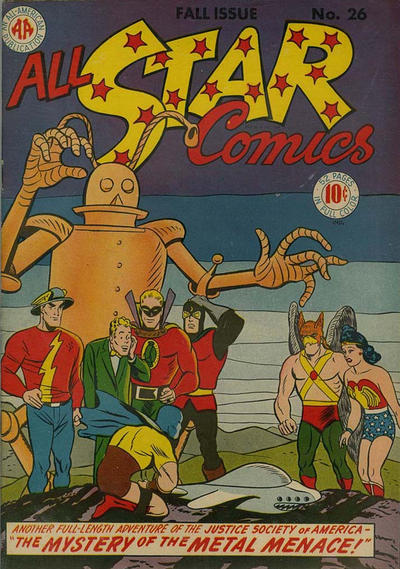 Though this would be the last issue of All-Star Comics which, if published as God intended, would have featured The Spectre, I'm not going to go into much depth with this "review". Unlike the previous issue where you can still see the seams of the Flash chapter of that adventure connecting themselves to our ghostly hero, the alterations to this piece extend beyond merely cutting and pasting Jay Garrick and the words 'The Flash' where appropriate. For a grounded speedster such as The Flash, our fleetfooted racer does have an unusual penchant for entering buildings via the roof and popping through ceilings in issue 25. He's airborne on that comic's cover and what kind of/sorta/maybish can be passed off as his racing with his body angled towards the sky, looks suspiciously more like he was intended to be racing through that sky instead. So in short, one can tell that something was off. I don't think the same applies for All-Star Comics #26 however. 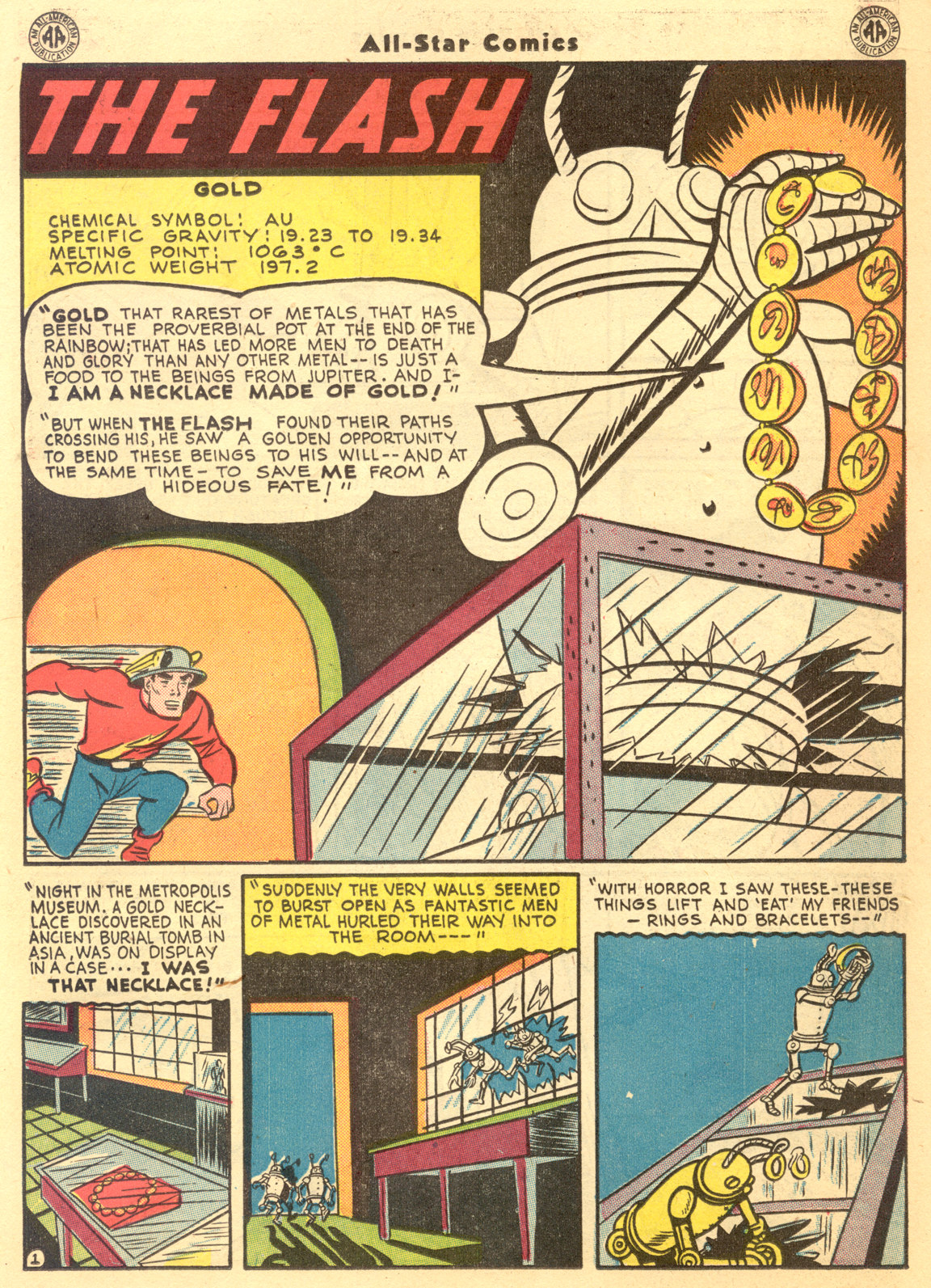 Synopsis Synopsis: Herbert Crawford is a scientist, astronomer, physicist, and metallurgist. He also believes that the Earth is due for an invasion. More specifically, he believes that a ship made of living metal crewed by similar such beings will reach Earth with disastrous results. Though Crawford hypothesizes that these aliens will prove to be no greater than four inches in height since anything larger would be incapable of movement, it is the ship itself which he worries will "eat anything with which it comes into contact!" Though Crawford fails to show up at The JSA's meeting when Hawkman expected him to, a radio announcement informing the group of strange happenings across the country pretty much dictates to the team the actions they must now undertake. "A silver mine has completely disappeared! All communications with Ivory City has creased! A subway suddenly disintegrated!" The call to action which brings forth The Flash sees him head to The Metropolis Museum where tiny metal aliens eat an assortment of metal and grow in size as a result. The Flash arrives upon the scene, but finds himself unable to come up with a means through which to battle these creatures. Observing them from a distance, he notes that the metal which the invaders are most intent in imbibing is gold. Realizing that by absorbing this element, the aliens are replacing their original metals, thus becoming "practically all gold", The Flash uses the malleability of gold to twist the aliens into knots and leaves them for the police. Thoughts: Though I have to wonder if Hawkman consulting The Flash at the start of this tale to get his informed opinion on a map of space really passes muster simply because "you are an accomplished scientist", I see little here that feels better suited for The Spectre. This chapter itself is narrated by a necklace which is just the sort of lame quirk you'd expect from a Gardner Fox penned Spectre tale, but the plot itself does seem as though it's keeping in line with the scarlet and blue speedster. Reference is made to The Flash's speed through the narration and if his image is still being pasted overtop The Spectre's, there's more effort involved than such a simple procedure would seemingly require. As M.W. noted, The Flash's helmet can neatly fit beneath The Spectre's pointy hood, but a panel where The Flash turns into a whirlwind seems like things were being rethought as well as redrawn. The story also provides Jay Garrick with an advantage The Spectre shouldn't need - though we're led to believe that he can't do much against beings of steel, The Flash can more adroitly handle creatures of the softer element of gold. The Spectre, of course, shouldn't have much trouble handling steel beings but also, of course, who knows when Gardner Fox is at the helm. 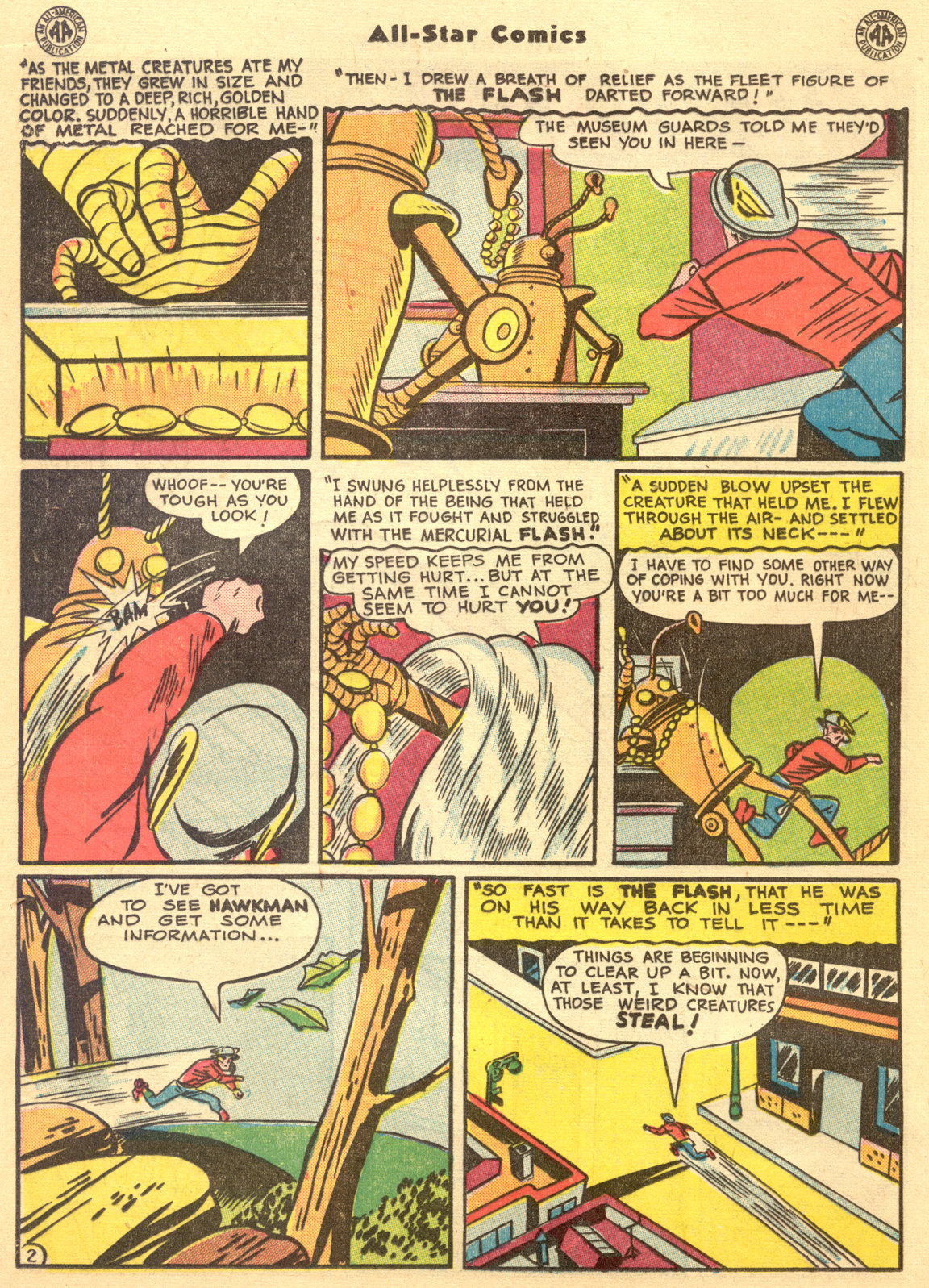 So a Spectre story at one point, but too much of a Flash one to really be considered anything else, in my opinion. As an indication of just how much rework was still going on at this point, note the first panel of The Green Lantern chapter (originally a Starman tale) where the illustrator forgot to get rid of Ted Knight's Gravity Rod. 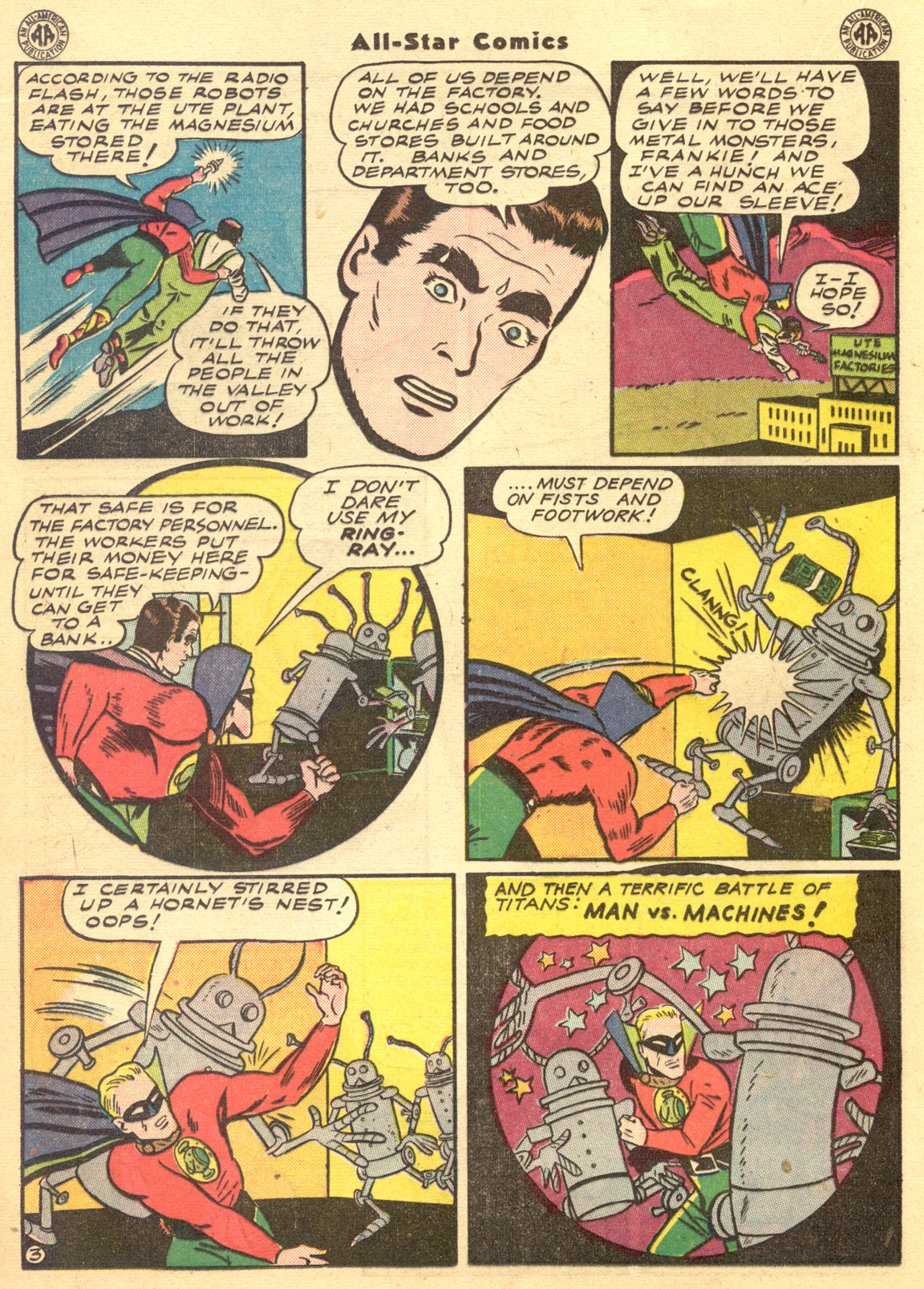
|
|
|
|
Post by MWGallaher on Oct 5, 2020 9:47:49 GMT -5
I was going to say that the lettering whenever "The Flash" is written suggest corrections, but then looking over the entire issue, I see that every hero's name is lettered in an awkward, sloppy bold style that looks like a last-minute re-do! But that opening word balloon from the necklace in the first page definitely looks like it originally had room for a couple more letters in the space currently occupied by "THE FLASH", doesn't it?
|
|
|
|
Post by chadwilliam on Oct 5, 2020 22:35:04 GMT -5
Back in April, Shaxper requested the following: I'd love if, once you are done with these reviews, you create a list of "essential" Spectre stories -- the ones you get after boiling off all the repetition, contradiction, and filler, because I LOVE this premise but absolutely struggle with reading one story after another.
With that in mind, I've compiled a list of sorts. To be honest, it's difficult coming up with a list of essential Spectre stories since so many seemingly significant features of the run would prove to be unimportant in very short order. Siegel came up with a very compelling list of ingredients for his creation at the start of his run which he never put to any meaningful use. Jim Corrigan loves Clarice Winston and she him, the two are going to be married, but Corrigan's murder puts paid to that notion. However, Clarice doesn't know he's been murdered since he's been granted an approximation of life as he ascends to the unknown. Corrigan doesn't feel that their relationship can continue, but his fiancee is persistent and knows that something is wrong. Meanwhile, Corrigan's best friend and partner Wayne Grant has, along with Jim, been assigned to catch The Spectre. Grant has also been on hand on a number of occasions when his pal has survived seemingly certain death. Something's got to give... Only nothing ever did. Clarice came and went, the "Catch The Spectre!" edict handed down by a Chief who was never given a name simply dissipated along with Grant, and the only idea which seemed to stick long term, was Percival Popp. Add to that the fact that The Spectre never really acquired a Rogues Gallery, that what should have been historic moments (ie. Clarice knows Jim's secret) are treated matter of factly and never referred to again, and that nothing really ever added up to anything, it's difficult and even rather pointless to come up with a list of key events. As for a recommendation? I'd honestly suggest you read More Fun 52-73, 77, and perhaps the first ten or so issues of All-Star. On the one hand, that doesn't really narrow things down beyond "those issues don't have Popp and with All-Star being more 'a portion of a larger story which happens to have The Spectre taking the spotlight for about five pages' the first ten or so should suffice" which seems lazy, but on the other hand, there wouldn't be much logic to a list containing certain omissions/inclusions when those omissions/inclusions would be based upon the fact that some tales could seem repetitive. I mean, if issue A seems a lot like issue B, how do I know which one to keep and which one to omit on a list of recommendations when, with all things being fairly equal quality wise, I'd simply be picking a story at random. So, that's my first recommendation (and even "the first ten issues of All-Star" is rather arbitrary) but that isn't to say that certain issues jumped to the forefront of my mind faster than others. Hence, my second recommendation...  More Fun 52-53 More Fun 52-53: Introduction of Jim Corrigan/The Spectre. Though not maintained for very long, this issue establishes the tone which sets The Spectre apart from any other superhero out there in 1940. A harbinger of death, he acts more as a mediator between our world and the next as he determines just how smoothly one's transition from here to oblivion should be. Like Death itself, he cannot be reasoned with or appealed to - that he leaves Gat Benson a gibbering wreck as opposed to a lifeless husk should not be construed as an indicator of mercy on his part, but as the inexplicable caprice of an entity who keeps his reasoning to himself. A force of nature - of God, actually - summoned by evil which he repays in full. More Fun 55: Introduction of Zor. There are beings who wield the same powers as The Spectre, but who have been playing this game far longer than he...
More Fun 57: Zor Returns. Had The Spectre been granted his own gallery of rogues, Zor would likely have ranked near the top of the list. As it is, this would mark his final appearance during The Golden Age. Also; want to know where The Spectre first battled an adversary using planets as bludgeons? It happened here first. All Star Comics 1: The Spectre displays his supernatural abilities in front of a large public crowd when he creates a beam of light to save the life of a young woman and her baby from a raging fire. If there is a single moment when the public becomes aware of his existence, this is it.
More Fun 59: The Spectre turns a gunman's weapon into a squirt gun. Still a formidable being whose bad side you don't want to find yourself on, but this demonstration of his lighter side serves of a portent of things to come when the strip will decline into slapstick territory. Thankfully, that's still quite a ways away.
More Fun 60: The Spectre becomes front page news when he is framed for kidnapping a train. Confirmation that The Spectre's existence is known to a wary public. This story also introduces the one-time foe Xnon whose declaration of battle "Science against supernatural" neatly underscores the peculiar fact that despite leading a supernatural existence, The Spectre is susceptible to certain manmade devices given that they are of extraordinary power. This is also the issue in which The Voice first bequeaths The Ring of Life to our hero.
All Star Comics 3: The Justice Society debuts. The Spectre is a founding member. More Fun 64: "Let him alone, Watson! The law will deal with him!" "Oh no, you don't! You're not going to cheat the law of making you pay for your crime!" The Spectre displays a preference for the law over justice in this issue when a murdered man decides to seek vengeance upon those who killed him. The one anniversary of his debut and a key component of The Spectre's makeup begins to slip. Though hardly a deputized officer of the law, one can detect the influence of an editor looking to tone down the series already. More Fun 66: Giant monsters tearing apart the city while The Spectre seeks an answer by travelling through a portal found in an old painting innocuously housed in a museum. Through that portal he comes face to face when a megalomaniacal madman seeking to rule his world and ours. How can I not list this epic adventure?
More Fun 74: Percival Popp debuts. More Fun 77 and the rest of his run in All Star will be the only places from here on out where you'll find a Popp-less Spectre. More Fun 75: Jim Corrigan addresses the fact that his corpse is still buried in the lake, has his humanity restored, and finds all barriers preventing his reuniting with Clarice Winston have vanished. With Corrigan and Winston embracing before the setting sun at the end of this tale, this story can easily serve as the coda to the series should one desire it. More Fun 80: Want to know what a late Golden Age/early Silver Age Spectre tale may have looked like? The King of Color with his outlandish costume and gimmicked helmet gives you a hint. All Star Comics 15: Clarice Winston (or some other girlfriend of Jim Corrigan whom we've never before met) is casually revealed as knowing of his other identity. More Fun 90: Jim Corrigan leaves the series when he joins the Amry. The Spectre will remain invisible for the remainder of his run in More Fun (though this won't be the case over in All-Star). More Fun 101: The Spectre series ends. He won't reappear for another 20 years. |
|
|
|
Post by chadwilliam on Oct 10, 2020 22:36:55 GMT -5
Had The Spectre somehow managed to survive long enough to see the end of the decade - say, through continued inclusion within The JSA - it's almost certain that his adventures would not have extended any further beyond 1951 when that series ended. However, like his compatriots The Flash, Green Lantern, Hawkman, The Atom, and others, he would not be forgotten and with the successful revival (of sorts) of those characters it seemed likely that at some point, The Spectre would be recalled from the ethers of history. The question is how? Though I believe that Robert Kanigher, Carmine Infantino, and Julius Schwartz were all in agreement that none of them expected readers who happened to pick up Showcase #4 in 1956 would recall the fact that an earlier Flash had graced the news stands five years previously, The original Flash was nevertheless provided with a passing mention in that debut issue featuring an updated Flash named Barry Allen in what feels more like a nod to the past than a means to broaden the new character's backstory. Jay Garrick, we were told, was a fictional character and Barry Allen was the real deal with his own origin and his own look. The same would prove to be the case when other Golden Age heroes were revived in short order - Hal Jordan had no connection to Alan Scott; Ray Palmer no link to Al Pratt - but that isn't to say that DC were completely against the idea of reviving older characters relatively intact. Six months prior to Jay Garrick's return in Flash #123, his comic relief companions The Three Dimwits would be reintroduced in issue 117. Though no mention is made of the previous Flash, nothing seems to have been changed about these ersatz Three Stooges. It's interesting to me that DC then, didn't seem entirely against the idea of reviving older characters without updating them first, but of course, that doesn't mean fealty was a given either. Which brings us to...  This is the second issue of Jerry Bails' Alter Ego fanzine published in 1961 and it contains the following three page story by 20 year old Roy Thomas.  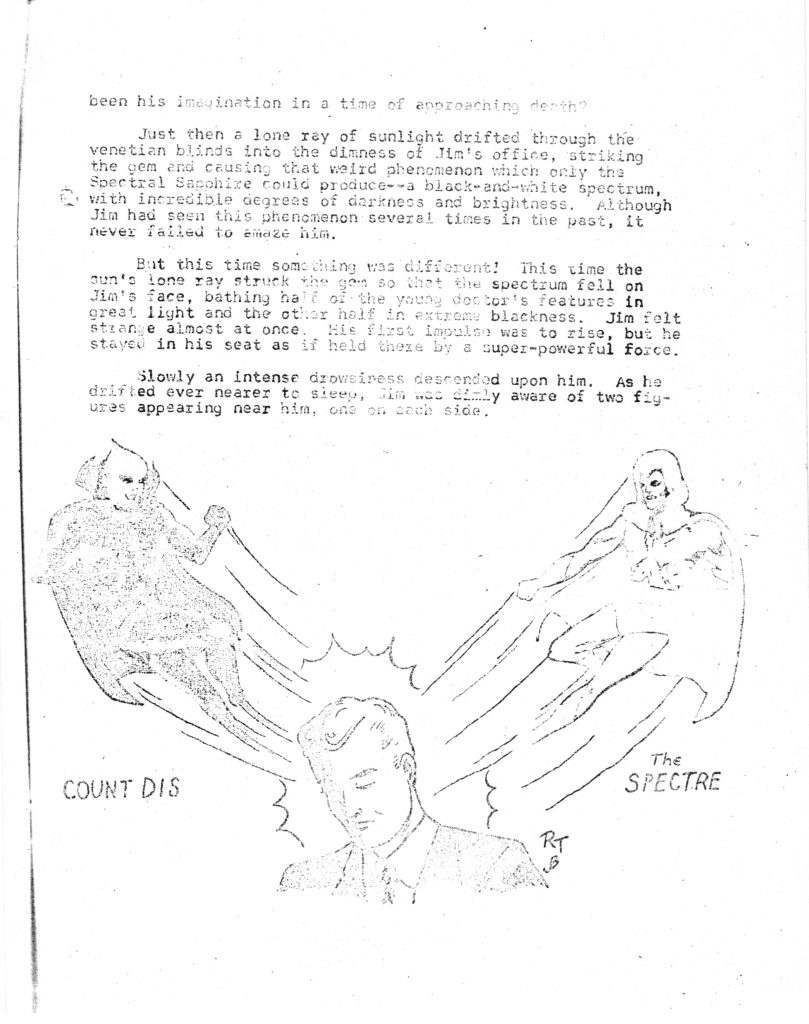 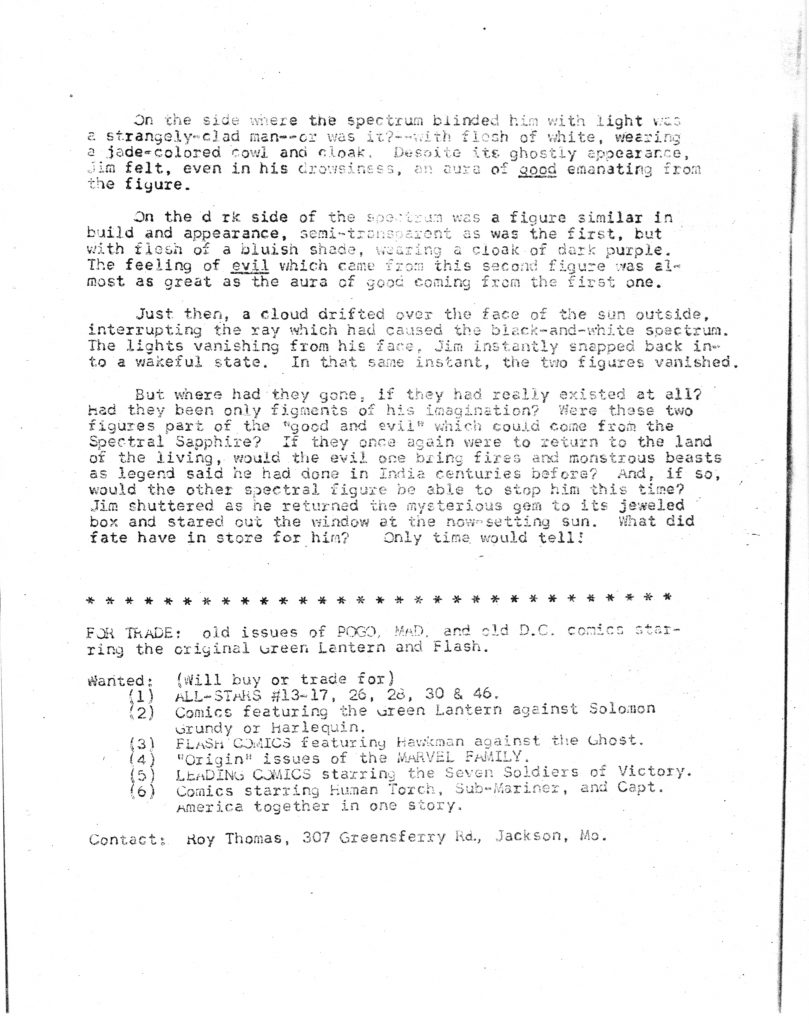 A dying Uncle who bequeaths a strange crystal unto his nephew doctor? A James Corrigan who has dabbled in the supernatural? A Spectre whose existence comes at the price of entering our realm alongside a darker half? Though a well scripted and intriguing piece of writing from an author who would eventually attain legendary status within the comic book industry, in 1961 " The Reincarnation of The Spectre" wasn't really being offered up as anything other than the fan fiction it was. Hardly a proposal to DC comics in other words, but that isn't to say that the company hadn't taken notice. Thomas, Bails, and plenty of others made up that subset of comic buyers who were aware of the medium's wonderful history. To fans such as these, five years was merely five years and for them, no character had been forgotten. Comic fans took note of Thomas' tale as evidenced by the fact that The Alley Award (first presented in 1962) for 'Hero/Heroine Most Worthy of Revival' was given to The Spectre (not literally given, of course). I don't know what sort of cachet such awards or even fans had in the eyes of DC at this time, but Thomas and Bails would have at least been known to the company through their fan letters (I believe that Thomas had a letter published in Marvel's Fantastic Four #5 this year). So... Jay Garrick hadn't been forgotten and it must have occurred to DC that the retooling The Flash, Green Lantern, et al had undertaken might not necessarily have been required when the time came for their revival. Though it probably had been, DC must have been wondering whether or not they could get away with bringing characters forward in time without inflicting the changes they had been administering to these heroes thus far. Could a character such as The Spectre be brought back in the form we had last seen him in in 1945? Or would he have to undergo changes marking him as a distinct entity from his previous self? For the answer, we'll have to wait until 1965... |
|
|
|
Post by chadwilliam on Oct 13, 2020 16:56:33 GMT -5


Showcase #60 (Jan-Feb 1966) "War That Shook the Universe!"
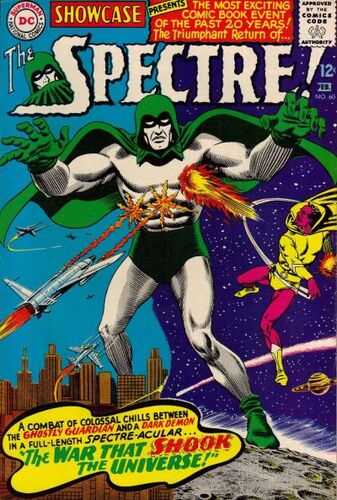
Author: Gardner Fox Artist: Murphy Anderson "He recalls how he used to stride across the world, a powerful phantom against whom the forces of evil could not survive! His was a mission of morals, to balance the scales against the criminals who preyed upon the weak and helpless..."
Synopsis: It's been 20 years since Jim Corrigan, now a Captain-Detective for "a Metropolitan police force", has been able to transform into The Spectre. Unable to account for the loss of his other half, The Spectre's absence weighs heavily upon Corrigan's mind especially now as he attends a seance at Treasure Castle in the hopes that secretary Millicent Olcott can discover where her late uncle and millionaire Ebenezer hid his fortune. "If only I could separate my physical and astral bodies -- the way I used to! It would be a cinch for The Spectre to locate that treasure!" the detective ruefully reflects as the seance begins with "psychic investigator, Stefan Miklos acting as medium. Just as an appeal to the spirit world is made to speak with any who could help young Millicent is voiced, Jim Corrigan experiences a sensation once all too familiar to the sidelined superhero. "The spell that has held me immobile in my physical body has lifted at last! I can feel myself dividing into two personalities!" And just in time too, for as The Spectre (fittingly, given his status when we last saw him back in 1945, as an invisible wraith) comes forth just as a hand grenade smashes through a window directed by the hand of criminals angered at the success Corrigan has had in thwarting their schemes in present times. 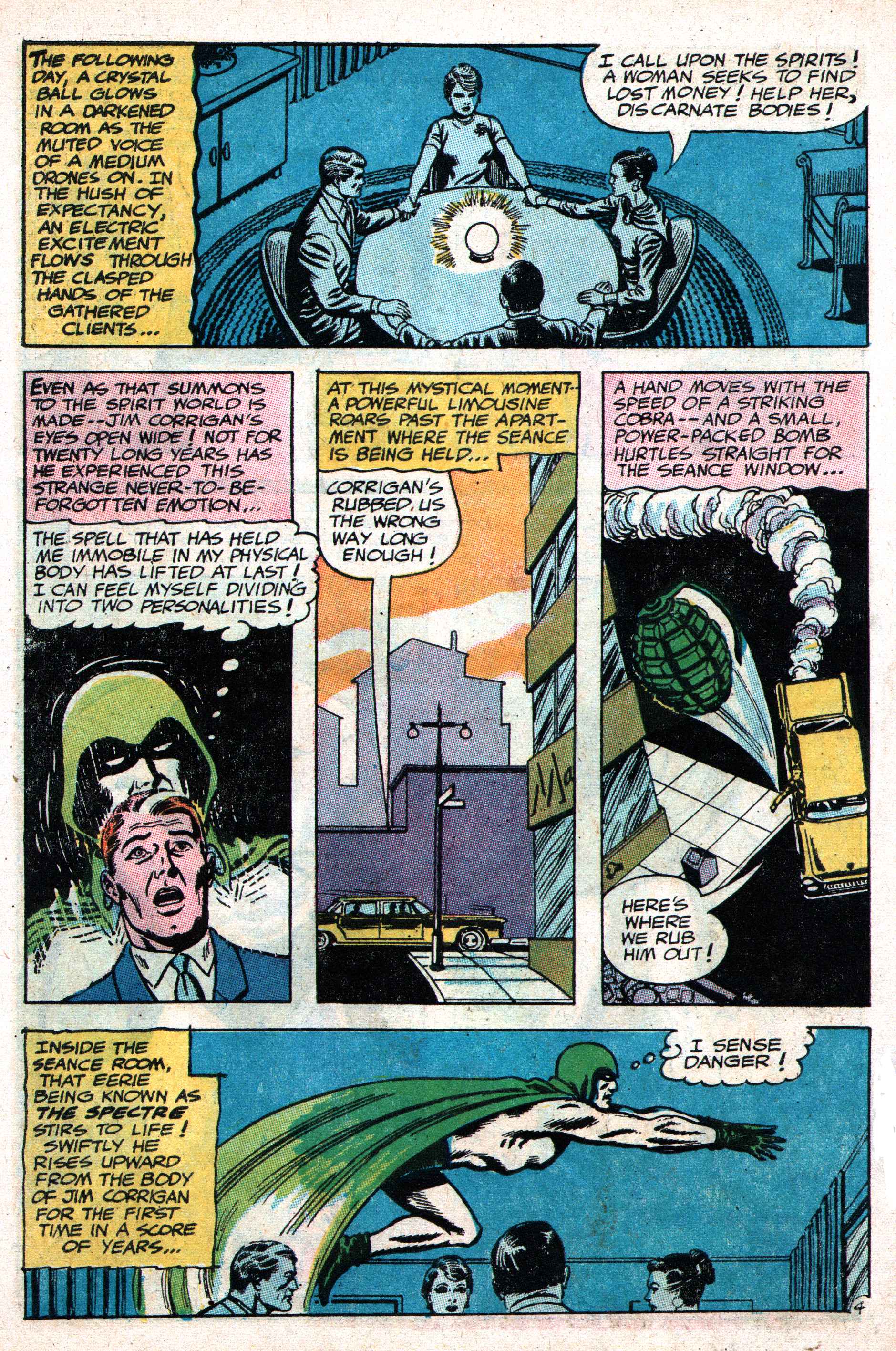 Commanding that "Time stand still about me!" The Spectre envelops the explosive within his cloak as he grows to sky scrapper height. With the assembled mass oblivious to the danger which just threatened their lives, The Spectre turns his attention to other matters. "What force kept me prisoner in the body of the man I once was? And -- what happened to release me just in time to save his life? While freedom is with me, I must find the answers to these questions!" The Spectre's re-emergence has also provided an additional unforeseen benefit. "The added astral power which appeared when The Spectre gained a new lease on life -- enabled Miklos to activate his own paranormal abilities!" How so? Well, as Miklos learns, the fortune they are seeking can be located at a warehouse on Water Street which becomes the trios next destination. Unfortunately, Corrigan isn't as on his guard as you might think the victim of an assassination attempt would be since upon arriving at the warehouse, he is blindsided by his old gangland foes Rocks Parker and Tuffy Cooper. Though not exactly on the best of terms themselves, Parker and Cooper have decided to join forces against the one enemy they hate more than each other. With a machine gun aimed at the detective at point blank range, things look grim for Corrigan, but fortunately for him, The Spectre hasn't exactly been standing idle since we saw him last. Using his "astral vision" to determine that Treasure Castle is empty, The Spectre summons up an image from the past. "Time rolls back its chronal curtain as the spirit sleuth recreates the past of moments before..." More specifically, The Spectre manages to watch as the car from whence the grenade tossed at Treasure Castle came speeds off towards the warehouse it has already arrived at. Materializing through the wall just as Corrigan is about to be gunned down, The Spectre grows in size and swallows the bullets fired at his old friend courtesy of Parker, Cooper, and their assorted men. This time however, he isn't invisible. "Yeow! Where'd he come from?" "Who is he? What is he?" 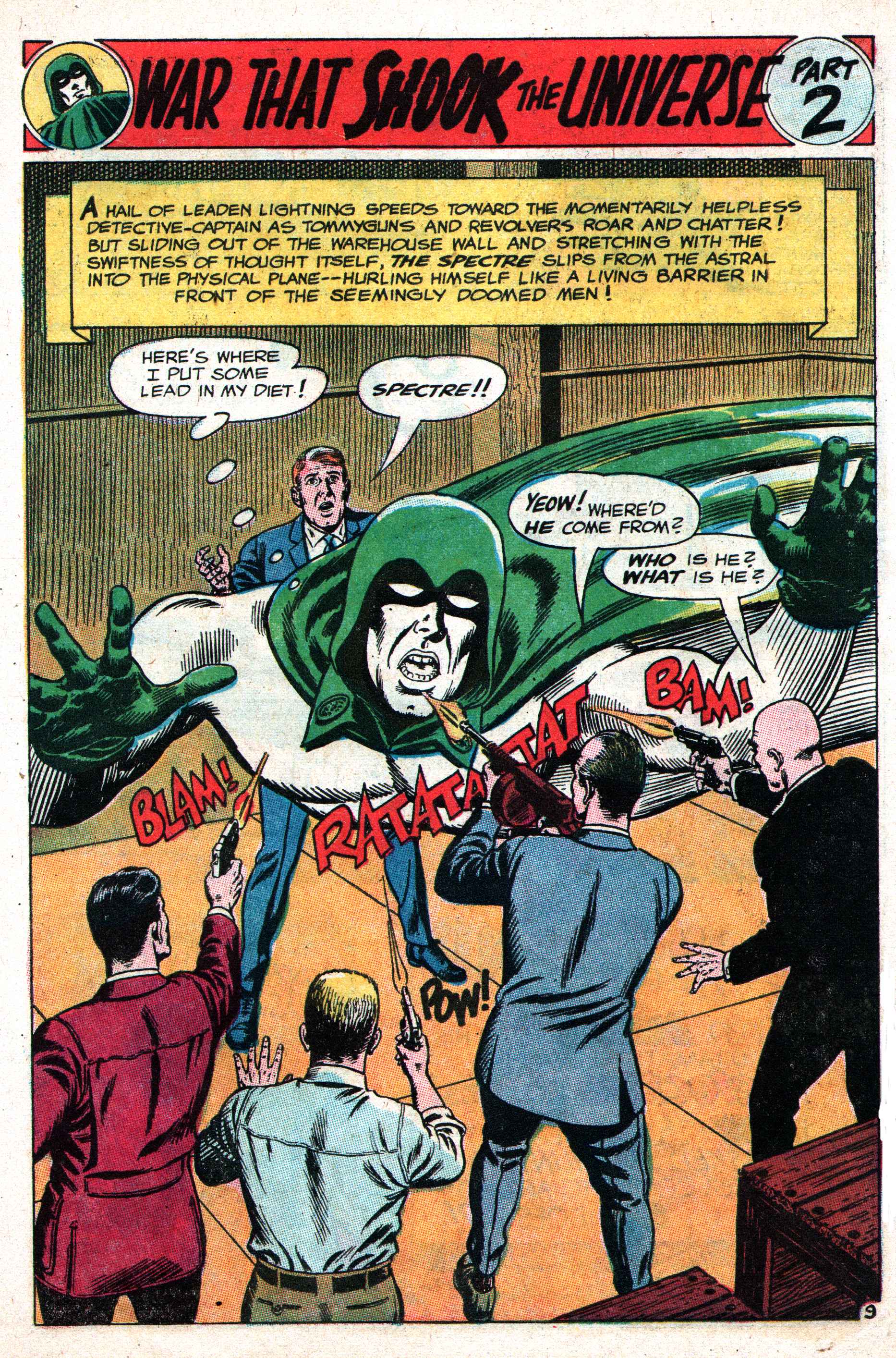 But while no explanations are forthcoming from The Spectre, one of the hoods recalls hearing his brother "talkin' about somebody like him". And with that, The Spectre's name is spoken aloud in his presence for the first time in 20 years. Foolishly, Cooper attempts to forget the ghost and retrain his efforts upon Corrigan when The Spectre admonishes him thusly - "No man ever forgets me -- once he samples the powers I possess!" With that, Spec turns the men's weapons into iron bars which wrap themselves around their users. The hoods are captured, Olcott's money is found and earmarked for his niece, and Corrigan and The Spectre reconvene at the detective's apartment that evening where they discuss the latter's absence over the past two decades. "Where have you been for the past twenty years? Why didn't you ever appear before today?" "I couldn't! I was imprisoned in your body by some force I don't understand!" With no simple explanation presenting itself to either party, The Spectre suggests that Corrigan continue to hammer away at Parker and Cooper's gangs which, in all likelihood, will be looking to recruit new bosses, as he seeks out an answer to the "source of uncanny energy that controls me!" Searching areas which emanate with high potent astral energy (the jungles of Ecuador; Salem, Massachusetts; Egypt; Mount Parnassus; Stonehenge) The Spectre finds no answers to his problem as Corrigan finds himself once again at the mercy of what's left of the Cooper/Parker gang when he's caught spying on one of their forest hideouts. Alerted to his dilemma through his unusual senses, The Spectre halts his search for clues to turn his attention to the hunting lodge where Corrigan is now held. Though down the hoodlums requires little effort on Spectre's part, the ghost is alarmed to discover his energy fading away as he is once again forced back into the host body of Jim Corrigan against his will. With his strength ebbing, the spirit pleads with Corrigan to track down a man named Paul Nevers in Mountain City for it is from he that the mystic powers overwhelming The Spectre emanate. Wasting little time, Corrigan heads off to Mountain City wondering how a small-time crook such as Nevers has been pulling off the spectacular crimes which have been attributed to him through the police teletype system. Corrigan doesn't have to look far to find his quarry for just as a taxi carries him from the airport to Mountain City HQ, he spots Nevers in the midst of successfully carrying off a brazen daylight bank robbery. Fantastically, the bullets fired at Nevers from the guards on-site merely bounce off his body as Corrigan gives chase. Despite having retreated into his host body, The Spectre is still able to mentally warn the detective that Nevers is "being helped by an astral being like myself!" To complicate matters further, Corrigan also feels the influence of an outside force trying to make him gun Nevers down in cold blood. Resisting the impulse, Corrigan tosses his weapon away and with that action, The Spectre frees himself once more. He isn't, however, alone. Rising from the body of Paul Nevers is a reddish, devil-looking fellow clad in a yellow outfit who introduces himself as Azmodus. "Twenty years ago I left the world of my astral plane to come to Earth! This was when you found yourself trapped, unable to leave the body of Jim Corrigan! It was my intention to roam the Earth as you do, Spectre! -- but bent on doing evil instead of good, for such is my nature!" As Azmodus further explains, because the Earth could not support two beings such as The Spectre and himself, each entity found themselves trapped within their host bodies until whichever poor soul housed our villain passed away. At that moment, The Spectre found himself freed at Treasure Castle, while Azmodus returned to his own astral realm where he made preparations for his return. In short, Azmodus has returned with a silver bullet "imbued with ultra-evil powers" designed to imprison The Spectre within Corrigan once and for all and free Azmodus when and if it enters the body of Paul Nevers. And so, having reached what appears to be an impasse, Corrigan and Nevers duke it out as The Spectre and Azmodus slug it out against "a backdrop of inter-planetary space". Meteors, comets undersea whirlpools, even the Aurora Borealis - all become weapons in the hands of the pair as they fight to what appears to be a standstill. However, an opportunity presents itself for The Spectre when Corrigan gains the upper-hand in his battle against Nevers. Pressing the advantage, the ghost flies Azmodus to "the rim of the astral universe" where the fiend is left to float in timeless space for eternity. Though winning what seems to be a clear, decisive victory, The Spectre is left with a warning from Azmodus that having anticipated the possibility of being unsuccessful in his attempt to defeat the ghost, the scoundrel has already set a plan in motion to avenge himself. And there the tale ends. Thoughts: The first Spectre tale in over 20 years and at 24 pages, it's also his longest thus far. No mention is made of Percival Popp, nor the fact that when last we saw him, Corrigan wasn't part of The Spectre equation. I suppose that if we assume that The Spectre disappeared in 1945, then that would put us chronologically past the end of the war at which point it would make sense for the returning soldier to rejoin his other half. That is, if Gardner Fox - yes, he's returned to pen this tale - even recalled how things were left back in 1944/45. As a matter of fact, I'm surprised at how accurate his memory (or effort made to research the character) is. In addition to being treated to two beautifully rendered panels courtesy of Murphy Anderson recreating the covers of More Fun Comics #54 and #60 respectively, Fox has reintroduced a number of abilities which I'm surprised he even knew about in the first place. 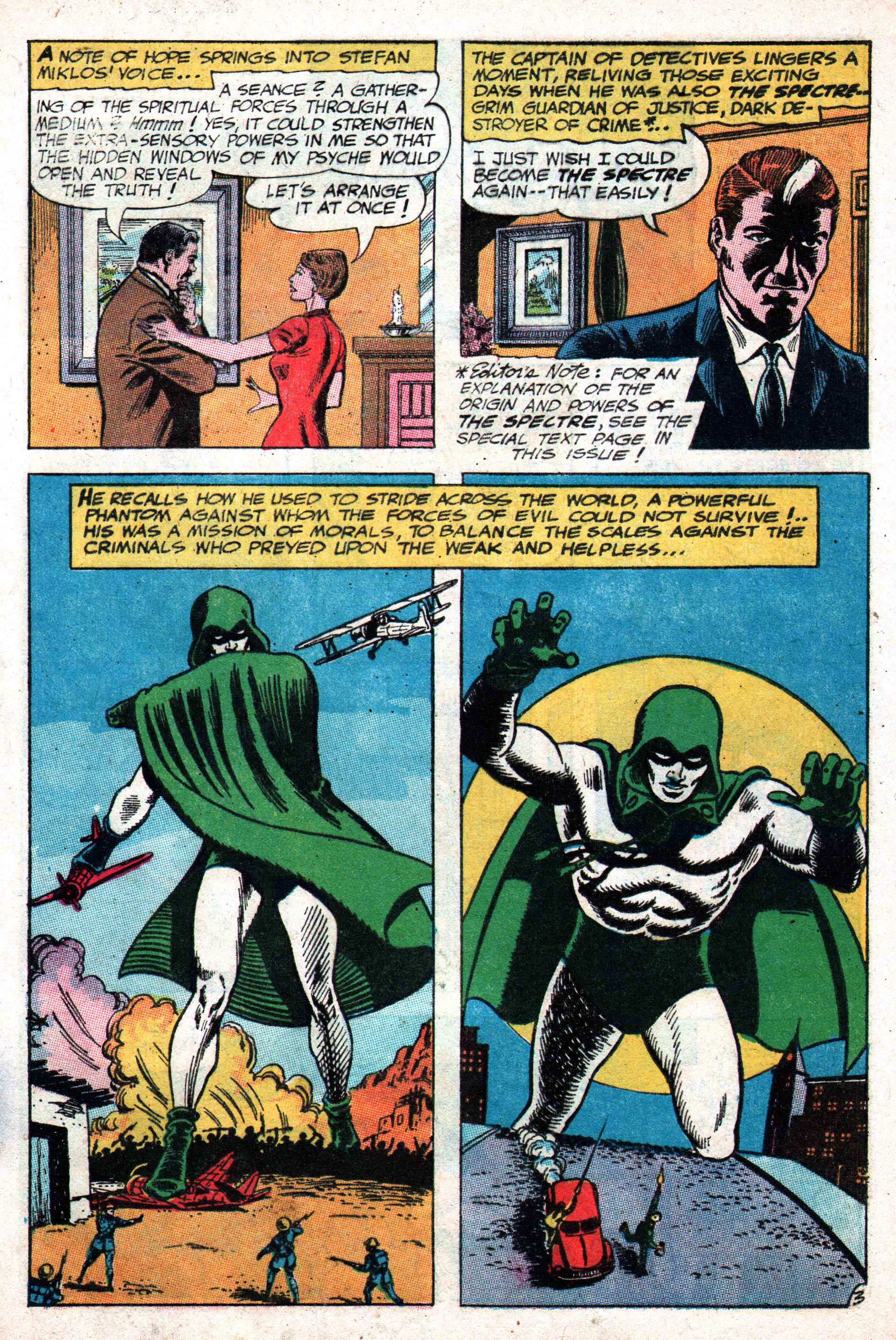 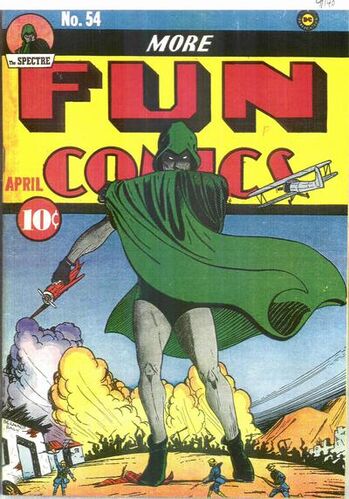 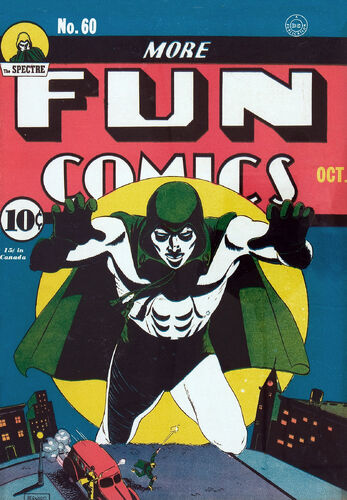 Firstly, The Spectre's ability to manipulate time itself so that he can view images from the past. I don't recall if Fox actually employed this supernatural talent during his Golden Age run, though Siegel certainly did. Secondly, The Spectre imprisoning Azmodus in a paralyzed state throughout eternity takes a page from Siegel's book (see; Zor) and was perhaps a little too grim for Fox's run. Thirdly, The Spectre swallowing bullets. Now, I believe Fox did pick this up from Siegel during his original run, but I'm kind of impressed that he reincorporated it here. The moment is undermined by The Spectre's quip "Here's where I put some lead in my diet!" (thankfully expressed as a thought and not spoken aloud, at least) and by the fact that as one of the tricks up The Spectre's sleeve it can be effective but as the first demonstration of his powers he puts into effect upon his re-emergence, it's somewhat goofy. And that's a problem. The Spectre has to first and foremost be frightening. Anderson does a nice job with the art, but there's little about him which suggests death. Anderson neatly shadows his eyes and of course, the cloak does suggest that of a reaper, but there's too much muscleman in tights to the character to really regard him as a walking corpse. Though his powers are derived from a supernatural source, Fox plays up his shapeshifting abilities (he grows in size, elongates his arm to swat a group of gunmen) so much, in my opinion, that it's easy to forget just what else he is capable of. While one might argue that there is little to distinguish between a magic based character such as, say, Zatanna, and a supernatural being such as The Spectre, there should be a distinction made between the two. The Spectre wrapping the Cooper/Parker gang in their own weapons is something any number of magicians could do, but paralyzing them with fear (or even a command) would be more specific to a walking corpse. Of course, I'd really like to see him turn them into dust or skeletons or whatever, but given the fact that this is 1965, such an approach would obviously not be allowable. Some really nice dialogue here. "No man ever forgets me -- once he samples the powers I possess!", "Your powers may be beyond the imagination -- but mine are enough to stagger it!", "I sense peril to my physical self! I must delay my quest -- to save him from the results of his!" "Here you shall remain for all infinity -- powerless to work your evil will on human or spirit-being ever again!" (a nice reminder that The Spectre should me meting out punishments without the least hint of mercy contained therein). Fox has also re-incorporated The Spectre's penchant for battling superpowered foes on a grander tableau as evidenced by having him toss planets, comets, etc. around when squaring off against Azmodus. This is, of course, one of the features introduced by Siegel, but I suspect that it is Anderson's rendering of battles such as this (here, and on forthcoming covers) which will explain how such images became ingrained in the minds of those familiar with the character long after his Golden Age run. I have to admit, my eyes tend to glaze over during such moments simply because I find two beings of limitless powers hitting each other over the head (even if it is with the Aurora Borealis) to be pretty boring. On the other hand, I'm intrigued by the fact that it doesn't seem quite clear how Corrigan's relationship with The Spectre works. Are they the same person or are they two separate individuals. It seems pretty obvious that Fox is taking the latter approach, but with Corrigan thinking of his transformation in the following terms - "If only I could separate my physical and astral bodies -- the way I used to!" and "I just wish I could become The Spectre again" - it's not very clear. The Spectre "senses" threats to Corrigan, but doesn't seem to share his thoughts despite referring to Corrigan as "my alter ego" at one point. It's hard to figure out how their partnership works though at this point, it seems that The Spectre is just a guy who happens to live in Jim Corrigan's body. Of course, comments such as those I cited suggest that there's a little more to it than that. Kind of a big coincidence that The Spectre just happens to be freed at the exact moment that an assassination attempt is made upon Corrigan. Even harder to believe, is that this occurrence coincided with the death of Azmodus' first host body. 20 years of co-existence and that guy just happens to die at the exact moment Corrigan likely would have? I guess you can chalk it up to the synchronicity of the Universe if you want. I liked this story. The Spectre's return feels like a momentous event and likely would have retained that feeling even if I weren't previously familiar with the character. Corrigan being trapped in a warehouse at gunpoint is a nice call back to his origin in More Fun #52 even though Fox may have not intended there be such a connection. That he is this time saved from a sad fate by The Spectre rather than forced into the tragic curse of having to become him, is a satisfying balance between his debut then and his return here. Anderson adds little touches here and there which recall the Spectre of old - a panel with skulls taking the place of his iris' is a nice homage to the image which graces the first post of this thread - and even as a "muscle man in tights" The Spectre looks cool under Anderson's pen. Fox has never presented The Spectre as this powerful and this vulnerable. Having him rescue Corrigan and Corrigan do the same sets up what really feels like an equal partnership very effectively. You really feel as if the two need one another to survive - literally, in The Spectre's case while in Corrigan's, one gets the sense that life has been unerringly bland for the Detective-Captain (nice that he's received a promotion after all these years). It'll be interesting to see where things go from here.  |
|
|
|
Post by MDG on Oct 13, 2020 17:53:58 GMT -5
I was going to say that the lettering whenever "The Flash" is written suggest corrections, but then looking over the entire issue, I see that every hero's name is lettered in an awkward, sloppy bold style that looks like a last-minute re-do! But that opening word balloon from the necklace in the first page definitely looks like it originally had room for a couple more letters in the space currently occupied by " THE FLASH", doesn't it? The way the studios subdivided work, I wouldn’t be surprised if one guy did most of the lettering and another did the bold |
|
|
|
Post by MWGallaher on Oct 14, 2020 10:51:07 GMT -5
Thanks for continuing into The Spectre's revival, chadwilliam ! I'd never seen that Murphy Anderson cover rough before--I wonder if this implies that it was his idea to insert that haunting head shot into the initial S. I've always thought that was a big part of what elevated this logo into the upper echelons of comics logos. It certainly doesn't look like he was otherwise copying Ira Schnapp's eventual logo. I wonder how awkward it was for Fox to mine Siegel's work as inspiration for this revival while ignoring his own run. "What, my Percival Popp stories aren't good enough for kids these days?! Fine, lemme see this early stuff again if that's what you want." It would have been fun to have a couple of panels worth of flashback showing Jim returning and rejoining with his alter ego, but then the setup between the two was already hazy enough without rehashing a period of a completely different relationship. It's interesting that this story features an "anti-Spectre", reminiscent of the Count Dis of Roy Thomas's fan-fiction. It's a natural idea to flow from such a god-like premise as The Spectre, but one that might not have fit neatly with the original conception: what kind of brutality would an opposite number dish out in contrast with the horrific justice being served by The Spectre in 1940? And as for the convenient synchronicity, I'll buy that if the Universe incapacitated both when Azmodus arrived, then it would try to take them both out at once when one got freed. (Hey, this brings to mind another memorable story from Spec's Silver Age run...but isn't the gimmick usually that the Universe tries to balance extreme powers? It would make more sense to imprison The Spectre in the event that his negative counterpart was sidelined, then set him free when Azmodus escaped. This story's trying to have it both ways! I think, anyway...now I'm all mixed up, but I don't think Gardner Fox had it all carefully worked out, either!) One other thing of note: Jim Corrigan now has a white streak in his red hair. An unusual visual acknowledgment of the passage of 20 real-time years, and one that does emphasize that Corrigan, at least, is a living, aging human being, not a ghost. Not that that helps clarify the confounding relationship which Fox continues to gloss over. |
|
shaxper
CCF Site Custodian
Posts: 22,874
|
Post by shaxper on Oct 14, 2020 10:55:15 GMT -5
Let me second how thrilled I am to see you continuing this thread!
One of the most frustrating things I experienced when I first read The Spectre's Silver Age appearances a decade back was how writers could not decide whether he was from, or even resided within, Earth One or Earth Two. It's possible we are reading the adventures of two different Spectres in this era -- the one who appears in these pages, and the one who worked with Percival Pop and appears in Justice League and Brave and the Bold.
|
|
|
|
Post by chadwilliam on Oct 16, 2020 0:05:47 GMT -5

Showcase #61 (March-April 1966) "Beyond the Sinister Barrier!"
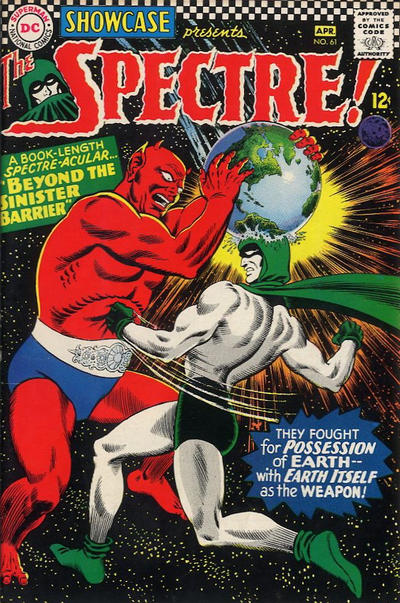 "I was lured here -- to be destroyed! To clear the path for -- what...?"Author "I was lured here -- to be destroyed! To clear the path for -- what...?"Author: Gardner Fox Artist: Murphy Anderson Synopsis: A Mongolian bandit, dying of thirst in the Gobi Desert is offered a strange proposition. A spelunker in France, trapped by a cave-in and facing certain death, receives a guarantee of life but with an unusual catch. So too does a big game hunter in Africa who finds herself out of bullets whilst in the path of an onrushing elephant and a window washer in Gateway City when he feels his safety harness break. The arrangement offered by this disembodied voice? Give me your shadow and you shall survive. None of the four refuse and all find exactly what they need to continue on this plane of existence. To whom have they granted their shadows? "It is I -- Shathan the Eternal! Master of Dis, ruler of the Psycho-Matter worlds! ... With enough human shadows I shall know life here as I have known it for all eternity in Dis, land of evil!" Witness to the fantastic escape from death for the last beneficiary of Shathan is Jim Corrigan who, as the window washer lands "as lightly as a feather" upon the ground several stories beneath him, a voice from within whispers, "look again". With this, Corrigan takes note of the man's missing shadow and accepts that this is a job for his other half. Drawn - quite literally - into the window washer from whom The Spectre senses "an evil aura" by "some form of ecto-plasmic magnetism" the grim guardian is ambushed by the fellow's missing shadow which emits enough evil energy to send our hero hurtling out of the physical universe. But if no longer a part of the physical universe, where then, is The Spectre?  Finding himself in the barren wasteland of Dis, a plane of existence steeped in a palpable atmosphere of "sheer evil", The Spectre is waylaid by an army of yellow creatures whose clubs, maces, mallets, what-have-you beat down upon his less than invulnerable form. Here, where these demons' weapons "are of the same structure as [The Spectre's] body", our champion's existence is very much at risk. "The abominations of all time are here! These fiends are the living incarnation of every evil known to man!" Fighting fiercely, The Spectre renders his body to such enormous size that though the denizens of this "psycho-matter" world might threaten him if he were to remain at his usual size, by growing large enough so that even "comets -- suns -- galaxies -- pass harmlessly through his super-size shape" The Spectre is able to focus his will towards the objective of returning to Earth -a feat which he accomplishes in short order. Materializing at Gateway Harbour, The Spectre is surprised to find that the eerie foghorns sounding in the distance speak intelligently to him. "You are puzzled, Spectre! Shaken by what you have seen and experienced! Know you that the forces of evil are abroad on Earth! Not long ago Azmodus sought to unleash universal wickedness -- but you stopped him! Now Shathan the Eternal seeks to rip the sinister barrier between the world of Dis and Earth! Already he has sought to destroy you, for he knows that through you must be fought the coming battle of good -- and evil!" Tasked with the challenge of going back to the beginning of time so that he may acquaint himself with Shathan's origins, The Spectre arrives 12 billion years in the past where he bears witness to "the primal atom" from whence came all things as it is struck by "a bolt of super-normal power" thus triggering creation itself. As he flees the explosion, a backward glance fills in the details The Spectre has until now not been privy to. Because "every action must have an equal and opposite reaction", another universe - that of Dis - was formed just as ours took shape. An "evil, malignant" reality consisting of psycho-matter is home to Shathan and he exists only because the denizens of these nether worlds believe in and worship him. To bridge the gap between this universe and ours, it was Shathan's intent to instill images of evil throughout Earth's history and in so doing, pervert our world to ensure his power here.  As The Spectre explains however, "The forces of good were not asleep! Great men rose up to lead the way of goodness... Moses... Peter... Buddha... Mohammed..." With Shathan successfully restrained, a secondary plan was put into motion by the demon God the cogs of which turned only last issue. As it turns out, Azmodus' arrival on Earth last issue was designed to smooth the way for Shathan and would have succeeded had our hero not intervened. However, with the belief in Shathan implanted within the minds of those who sold him their shadows, the demon's power grows ever stronger and now threatens to curtail and invalidate the forces of good. Considering the possibility that as Earth's agent of good, this may very well be the reason he was created, The Spectre returns to the body of Jim Corrigan to contemplate his next move. As one might have guessed, Corrigan is at this moment busy slugging it out with a criminal as part of his everyday duties. Having just delivered what seems likely to be the final blow, Corrigan encounters a far greater problem when the cables securing the elevator into which his battle has led snap at the fingers of Shathan as they penetrate our world to complete this very task. Though the detective is oblivious to the cause of the break, The Spectre is not. Rescuing his other half along with his catch, The Spectre is puzzled as to why Shathan should bother targeting Corrigan since he cannot conceive of a reason why the detective should pose a threat to the demonic being. When Shathan strikes at Corrigan again the following day, The Spectre - having successfully prevented the assault a second time - deduces that his foe's objective is to keep him busy as he amasses the army with which he shall enslave the world. Sure enough, The Spectre has guessed correctly. Using his "paranormal senses" to track Shathan and his worshippers to "a long-forgotten temple" The Spectre arrives after the nick of time. With his worshippers chanting a chorus which has broken the barrier between our two planes of existence, Shathan materializes before his audience which now includes The Spectre. Gloating that our champion is too late to stop him, The Spectre nevertheless plows into his foe who is startled to learn that while the wall through which they pass cannot even touch his psycho-matter form, The Spectre's fists - being made of the same substance of Shathan - can. Recognizing that Shathan's close proximity to his worshippers only increases his strength, The Spectre takes the battle to the skies where he believes that he will have a chance to defeat the monster. Shathan's confidence grows when a swing from The Spectre fails to connect but the fiend is taken by surprise when his opponent's fist detaches itself from his body, picks up speed as it flies the distance of the hundreds of billions of light years which make up the universe, and strikes the villain from behind once it has curved around the length of space-time itself and winds up close enough to where it started to knock the demon in the back of the head. In case that's not clear I'll re-iterate that, yes, The Spectre successfully detached his fist so that it could journey around the curvature of the universe just so he could punch his opponent in the back of the head. Man. Despite connecting, the blow accomplished little more than dazing Shathan who retaliates by flying himself and The Spectre towards the sun. Suspecting that such a gamble will prove fruitless, The Spectre begins to doubt whether he can even stop this menace, but one hope does enter his consciousness. "Shathan is not all-knowing, though he seemingly is all-powerful! He is not familiar with this matter universe as he is with his own world of Dis! Therein lies my only hope of victory! I must use the forces of good... one of which is time that heals all wounds! I shall take him back in time with me, to the most destructive events on Earth! Not knowing about these awesome disasters -- he will be unprepared for them!" To October 30, 1961, the pair travels where a 57 Megathon Nuclear bomb detonates over Russia triggering the greatest man-made explosion in Earth's history. The explosion has little effect. To June 30, 1908 travel the psycho-matter representatives of good and evil where a fireball speeds above The Yenesei River in Siberia. Though ensuring that Shathan is tossed within the resulting inferno when the fireball touches down, once again, no lingering effect presents itself when the demon rises from the disaster. Even adding Krakatoa to the list doesn't affect Shathan and The Spectre realises that he has but one last chance to triumph over the devil. Returning once more to the dawn of time, The Spectre tosses Shathan into the primal atom itself just at the moment of creation. Confident that his threat is over, for with his atoms spreading throughout the universe at a speed ensuring that they can never regroup hope would seem to be lost for Shathan, The Spectre returns to the present and assures his followers that their fears are over for "good has won out over evil!" The tale ends with The Spectre racing back to Corrgian whom he senses is in danger. Finding his other half slugging it out with a gunman and watching as Corrigan takes him down, The Spectre reflects that "As Jim saved the city from lawless men, so I saved the world from an evil demon! Together, we shall continue our unending efforts to make Earth and its universe safe from any threat!" To which I can only say, "Thanks, Spectre and Jim!" Thoughts: Corrigan's city gets a name this issue - Gateway. We'll see if it sticks. Fox has really committed to this story. It has breadth, spanning as it does from one universe to another; from one period to another; scope, as evidenced by Fox using the concept of good and evil as the template for his tale; and ambition, treating last issue's yarn here as if it were a mere warm-up for the larger battle at play this time around. Some of this, of course, must be credited to the excellent artwork of Murphy Anderson whose realistic approach to his artistry makes it easy to buy into this story, but Fox is clearly giving it his all here. 20+ years ago, he was recycling plots only an issue or two after first introducing them as if he retained little recollection of what he was writing month after month, but, like I said, he's really committed to what he's doing here. Not that he takes it all completely seriously - that bit with The Spectre's fist doing a lap around the universe just so the guy can land a sucker punch on Shathan is out there - but there's obvious effort going into this. I have to admit that I'm disappointed to see Jim Corrigan take such a backseat to the proceedings this time around and I remain puzzled as to what the character means to The Spectre. Shathan makes two attempts on Corrigan's life and The Spectre wonders why. Should this be such a mystery? I mean, wouldn't doing away with Corrigan at the very least inconvenience The Spectre who makes Corrigan's body his home? To be honest, I really don't know. Does The Spectre need to reside within Corrigan? They seem to be two separate people here, neither dependent upon the other. Corrigan's part in this story is almost entirely reserved to being what the story cuts away to when its not focused on The Spectre and when that happens, it's almost always a scene of Corrigan engaged in bare-fisted fighting with some hoodlum. So that's pretty much what Corrigan does all day - just get into fistfights with one criminal after another and it's pretty tedious. That you'd think such occasions would at least warrant a "I could use The Spectre's assist here" reflection on his part doesn't seem to occur to a guy who uttered such lamentations just last issue. I guess, as a matter of pride, Corrigan doesn't want to rely on The Spectre when he's got his own bare knuckles just champing at the bit, but if he's not going to call the guy in for his cases or help him out with his, just what is the status of their relationship? I had thought that the reason Fox got rid of Corrigan back during his More Fun stewardship was to give Popp more to do, but now I suspect that the writer simply didn't have much interest in exploring the dual nature of a half ghost/half mortal being which is a shame. One of the compelling features of the early Spectre exploits was the fact that it seemed to be a strip about a guy who also happened to be a dead man. The series was as much about Corrigan as it was Spec, if not more so. The kind of disruptions that afflict one's life when trapped within such an unusual bodily timeshare agreement. Corrigan realizing that he no longer has to breathe; that while still a cop and still in love with his fiancee, he's really just going through the motions whenever he engages in the behaviors associated with those roles after his death; even knowing beforehand that each case will, if successful, end in some coldly meted out death or punishment at the hands of his alter ego. This is the entity which should reside within him, but here, it doesn't even seem as if Corrigan has a clue as to what Spectre's been doing this issue. Fighting a stand-in for Satan himself and yet I suspect that all Corrigan is focused upon is which hold-up he's going to slug on the jaw next. Their lives don't seem to intertwine - it's like they're room-mates whose schedules ensure that their paths will never cross. Of course, I'm basing this all upon a single tale and things will likely change, but it is a bit startling to realise how willing Fox seems to be to not use Corrigan at all. As for The Spectre, I don't think these larger than life battles are really for him. I certainly admire and respect the complexity of what Fox is doing here and that bit about a whisper offering to trade a life for a shadow is just the sort of quality I liked about a lot of his early tales where in little, overlooked corners of life we'd find some subtle, sinister threat - but Spectre slugging it out with a demon page after page gets tedious after a while. I suppose the idea is to counter complaints that The Spectre is too powerful to be believably challenged by a foe, but I think Fox is going to have to try something else to keep readers engaged and I think that something should be something relatively psychologically complex rather than "how much bigger can the next explosion I incorporate into this tale be?" Still, I'd be lying if I didn't say I liked The Spectre's Gordian Knot approach to getting rid of Shathan by simply tossing him towards Ground Zero of the Big Bang and saying "that should do it". One other thought - I can't help but notice that Fox's Good vs. Evil bit here with Evil having ties to Dis sounds similar to Roy Thomas' short piece from Alter Ego #2. Could be coincidence, I suppose, but I do wonder. 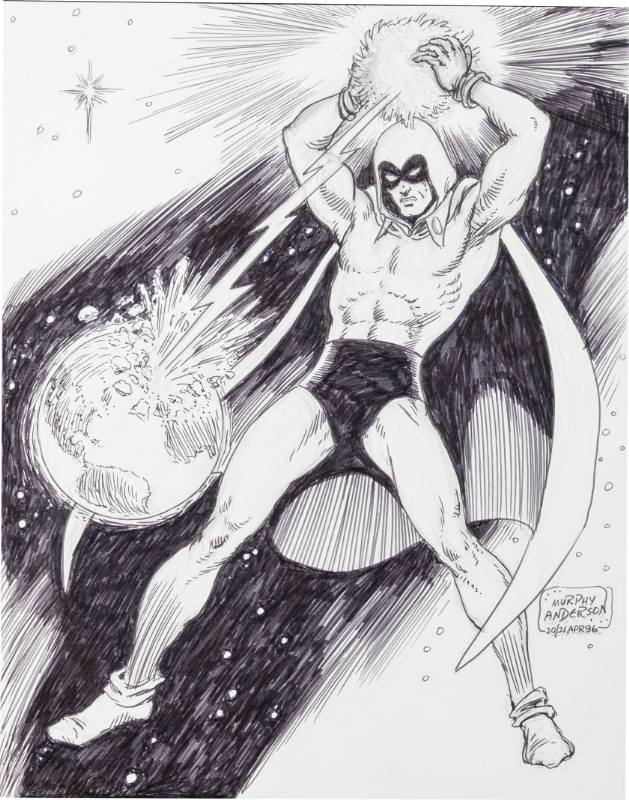 |
|
|
|
Post by MWGallaher on Oct 16, 2020 6:03:17 GMT -5
Fox's Weird Tales-inspired stuff here was, at the least, different than anything else happening in comics on an on-going basis at the time. Its closest competitor, Dr. Strange, was battling Eternity at about this time, so similar cosmic scale, but a very different vibe--things like civilians trading their shadows for their lives isn't the kind of notion I'd expect from Ditko's Master of the Mystic Arts.
I've scratched my head plenty over the Corrigan/Spectre relationship, both in this thread and "off-panel". I've concluded that what troubles me is the sense that Gardner Fox does in fact have a concept in place, but it's one that he thinks is so obvious that he doesn't have to explain it to the readers. Exactly what that concept is, I don't know, but I suspect it made sense to him. At least, he writes as if it did. As I recall, Neal Adams attempts to establish some ground rules once he takes over, so hang in there!
I'm struck not so much by similarities between this and Roy Thomas's daydream of a Silver Age Spectre (Fox was most likely on Thomas's mailing list for Alter Ego) but by the similarity between this story and Marv Wolfman's Crisis on Infinite Earths, which also takes the Spectre to the origin of the universe, birthing alternate universes, including Fox's Anti-Matter universe. I don't recall there being any mention of that being Spec's second trip to the dawn of time, but they were pretty busy...
|
|























